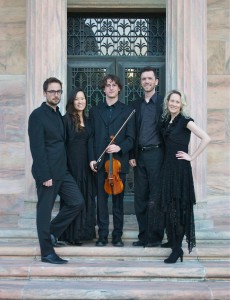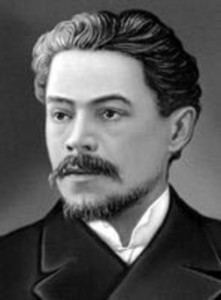Monday’s Westminster Concert Series concert focuses on three 19th century composers who epitomize French romanticism: Camille Saint-Saëns, César Franck and Gabriel Fauré.

From left: Claude Halter, Anne Lee, Alex Martin, Joel Gibbs and Karlyn Bond (Photo: Courtesy Westminster Concert Series)
There is a common thread among the three composers, according to pianist and series director Karlyn Bond. “These three composers had something big in common besides being French; they were all virtuoso organists and held positions in major Paris churches for years. Franck’s style was significantly influenced by his understanding of the organ (particularly the mammoth French organs of the 19th century, with their somewhat unique expressive potential), and his improvisatory genius at the instrument, for which he was celebrated for decades at St-Clotilde,” Bond wrote in an email to Reichel Recommends.
On the program are Saint-Saëns’ Piano Trio No. 1 in F major; Franck’s Sonata for Violin and Piano; and Fauré’s Piano Quartet No. 2 in G minor.
“Of these three works, the Franck is by far the best known, an indisputable masterpiece, and one of the most beloved works in the violin/piano repertoire,” Bond said in her email.
Saint-Saëns is best known today for his orchestral music and not so much for his chamber music output, something Bond laments. “The Saint-Saëns piano trios are not frequently performed but deserve more attention than they receive.”
Franck wrote only two piano quartets, and the one on the program happens to be the least known of the two. “Of Fauré’s two piano quartets, the C minor has received more attention than the G minor, though the latter is a truly impressive work. In it, romantic restlessness and intensity are perhaps even more pronounced than in the C minor, and more frequently interwoven with quirky, unexpected harmonies and harmonic progressions. About the serene slow movement, Aaron Copland said, ‘Its beauty is truly classic if we define classicism as intensity on a background of calm.’”
Joining Bond Monday will be Utah Symphony colleagues Claude Halter and Alex Martin, violin; Joel Gibbs, viola; and Anne Lee, cello.
- CONCERT DETAILS
- What: “An Evening of French Romanticism”
- Venue: Vieve Gore Concert Hall, Westminster College
- Time and Date: 7:30 p.m. March 23
- Tickets: $15 general, free for students and Westminster College faculty and staff with I.D.
- Phone: 801-832-2457
- Web: www.westminstercollege.edu/culturalevents

